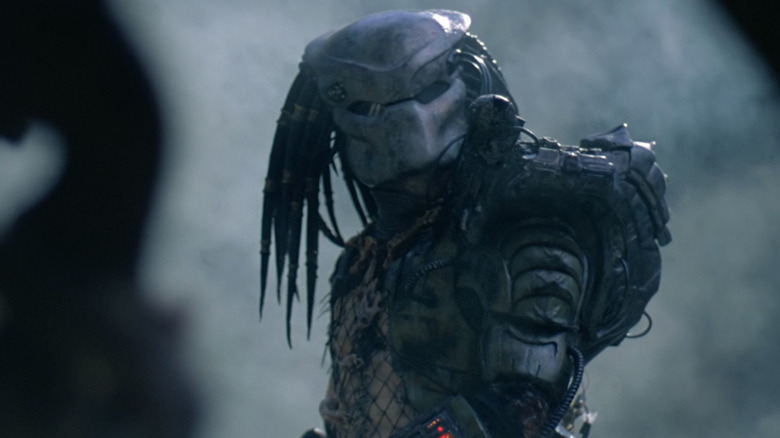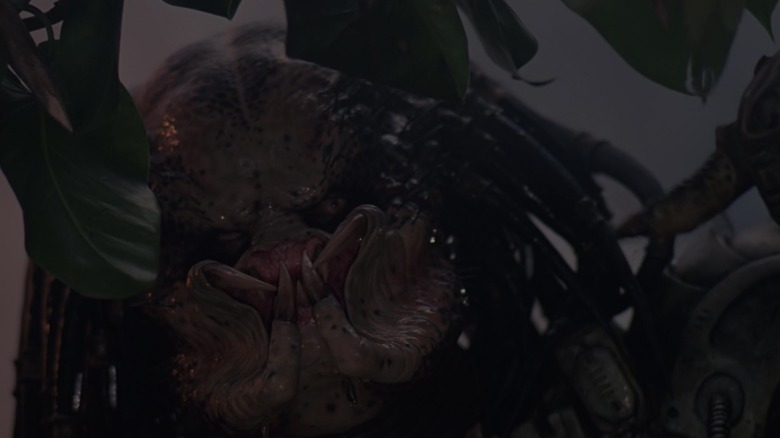Predator Dreadlocks Are Not Hair - Here's What They Really Do
The original design for the creature in John McTiernan's 1987 actioner "Predator" was initially spindlier and more animal. It stood taller and sported enormous yellow eyes and a horse-skull-like head. Fun trivia: Jean-Claude Van Damme was the original stunt performer hired to play the spindly version of the Predator. More fun trivia: in the sequel "The Predator," during a Halloween Night sequence, a little kid walks by the camera wearing the original Predator as his costume.
The eventual design for the Predator — called a Yautja in expanded universe lore — was far more humanoid. The Predator was a tall man with a muscular, male physique. It had long claws, shark-like skin, and was outfitted with high-tech alien hunting gear. It wore a mask for the bulk of "Predator," but eventually removed it to reveal a crab-like face, mean eyes, and an undeniably vulval mouth with fangs. The predator's vaginal face is in keeping with the film's overall satirical depiction of overblown, cartoonish masculinity. The design was striking enough to carry over into six additional films, not to mention a wide panoply of additional "Predator" media, including video games, comics, books, and toy lines.
Most striking, the Predator sported dreadlocks which whipped around dramatically when it turned its head. The dreadlocks even had small rings and bangles attached and looked pretty badass. Every Predator seems to wear their hair in a similar fashion.
The vast sea of "Predator" expanded universe lore, however, reveals that those locs aren't hair at all. If one does a deep dive into the many "Predator" comic books, one will find that those cranial tendrils are actually complex sense organs that assist a Yautja with its balance and reflexes.
The Predator's dreadlocks are actually a series of complex sense organs
In Brian McDonald's 1996 comic book "Predator: Strange Roux," one of the title creatures, while hunting humans in the swamps of southern Louisiana, was shot in the head by a local trapper. The shotgun blast blew off several of its "hairs," and they actually started to bleed. This was positive, semi-canonical proof that the Predator's cranial tendrils were definitely not hair, but a series of boneless protrusions on the creature's head. Later in that book, a trapper gets the drop on the Predator by luring it into quicksand, killing it ... and making it into a stew. It seems that Predators are edible.
The actual biological function of the Yautja's tendrils, however, wouldn't be made explicit until the 2008 novel "Predator: South China Sea" by Jeff VanderMeer. That novel finally clarified that the tendrils provided enhanced sensory input for a Predator, giving it a better sense of balance than a human. They also seemingly provided some sort of "spider-sense" effect to the aliens, as they also improved a creature's reflexes. The conceit laid out in "South China Sea" also explained why an imprisoned Yautja had its tendrils removed in the 2005 video game "Predator: Concrete Jungle."
Given that the Predators decorate their tendrils with bangles and rings, there is clearly an aesthetic aspect to their "dreadlocks" in their culture as well. Perhaps the same way one might pierce their nose. In David Bischoff's 1994 novel "Aliens vs. Predator: Hunter's Planet," a human named Machiko Noguchi falls in with a pack of Predators, becoming an ally. To better fit in, she grew her hair to look like a Predator's tendrils. When they are cut off in the novel, Machiko laments that the male Predators won't find her as attractive. It seems long tendrils are considered beautiful to the Yautja yobbos.
What Stan Winston designed the Predator dreadlocks for
The Predator was designed by master creature designer Stan Winston, who also created monsters and robots for "The Terminator," "Jurassic Park," "Aliens," "The Thing," "Edward Scissorhands," and hundreds of others. He won four Academy Awards for SFX and makeup. In interviews included on "Predator" DVDs, Winston revealed that the "dreadlocks" were envisioned as quills, perhaps like a porcupine. He didn't offer many details beyond the word "quills," but his use of the word implies that Winston wanted the dreadlocks to be more hair-like and perhaps even detachable. It wasn't Winston who felt they ought to be blood-filled sense organs.
Fun trivia: when the Yuatja engaged its cloaking device in "Predator," a close look will see that its dreadlocks aren't part of its shimmering silhouette. This was done because employing the invisibility effect on the hairs was too complicated for the SFX team. They decided to get around the problem by simply removing the hairs for invisibility shots. It's okay, because it's hardly noticeable.
Other looks around the "Predator" franchise reveal other details as well. For instance, most of the deadlocks are black, but some Predators have had blue or red ones. Older Predators seem to go gray. In the feature film "AVPR: Aliens vs. Predator – Requiem," a Predator is implanted with a xenomorph egg, and the resulting offspring is a combination of Alien and Predator ... with dreadlocks. That was a pretty sure sign that the "hairs" were a fleshy part of the monster's head.


